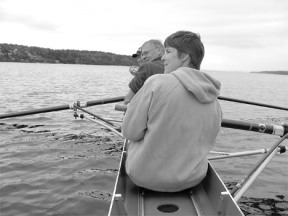It didn’t take me long to figure out I was in over my head Saturday.
I had been invited to check out the Island Rowing Association’s bi-monthly trek onto the waters of Holmes Harbor.
Hey, I like boats — tug boats, sailboats, canoes, aircraft carriers and ferries — all kinds of vessels.
But a long, narrow, floating shell with a freeboard from the edge (gunwale) to the water measured in inches?
Specifically, the boat was
45-feet long and 18-inches wide, built to carry five people but stay lightweight; not my idea of a steady platform.
Gently rocking in the water next to the Freeland dock, the fragile-appearing craft struck me as decidedly wobbly.
And it was, too, as I soon discovered.
Founded in 1997 by Dave Haworth, the Island Rowing Association is much more stable. The nonprofit association was formed years ago to promote the sport of rowing on Whidbey Island, according to current president Carl Fjelsted.
“We’re all about people with different backgrounds and ages — from 12 to 70 — who enjoy working together to get the boat from point A to B as fast as possible,” Fjelsted said. “We do this by offering youth and adults opportunities to row, combining a learning, recreational, social and competitive experience that promotes health and improves life skills in the pursuit of rowing excellence.”
“Excellence” wasn’t at the top of my priority list Saturday morning; I just wanted to get the day over with and not make a fool of myself.
The boats are stored in Fjelsted’s back yard in Freeland; he and Rob Setlow loaded them onto a special trailer before heading for the dock, installing the slider seats and carrying the 180-pound boat to the water’s edge.
Fjelsted’s daughter Nicki, a freshman at South Whidbey High School, served as coxswain (pronounced cox-n), the person who steers the boat from the stern facing the rowers while giving commands.
My job was to be the bowman, the guy sitting in the first spot at the bow, presumably so I couldn’t cause too much trouble.
After doffing my shoes,
I stepped gingerly into the boat to sit on the slider seat, stuck my feet into the foot stretcher and grasped the single long oar for dear life as the craft rolled alarmingly.
The others took their positions and we drifted into deeper water.
The key to the sport is maintaining a balance between what you do individually while matching your own moves to the others.
The oar, securely held in its lock, ends in a blade that must be vertical when it enters the water — the “catch” — allowing it to pull properly as the rower strokes. After the stroke, the blade is feathered horizontally by rotating the oar, allowing it to maintain contact with the surface.
The whole thing must be timed with the other three rowers or chaos ensues.
And it did, repeatedly, every time I dropped the blade into the water too far, disturbing the complicated rhythm.
Fjelstad was a patient coach, gently explaining what I was doing wrong. Gradually, I got the hang of it. There is a pattern of specific movements to master; after that it is repetition.
As Haworth explained to me later, all the energy of the four paddlers is at the blade where it hits the water; controlling that power in synch results in a boat that resembles an arrow gliding across the surface when viewed from above.
We raced across the smooth harbor at speed and I discovered how much fun the sport can be.
As coxswain, Nicki called out commands such as “back down,” “hold water” and the ever-popular “weigh enough” which meant stop rowing and take a much-needed breather.
Setlow’s daughter got him involved in rowing.
“Liz joined the Everett Racing Association and I would drive her over after school; I got hooked,” he said.
He also explained why calm days are best and why it’s common to see rowers out on the water at daybreak.
“The boats blow around too much in the wind and with the low freeboard, it isn’t much fun,” he said. “That’s why we start early in the morning.”
This was only the second time on the oars for Ruth Cox.
“I heard about it and wanted to give it a try,” she said. “Everyone is very patient and I quickly discovered rowing really is an awesome experience.”
Surprisingly, the tough workout resulted in few aches and pains the next day, apart from a little stiffness in the hands.
I might try this again.
Joining the association costs $25 a year; for details visit www.islandrowing.org or call Fjelsted at 331-3960.
Better yet, simply show up at 8 a.m. Aug. 4 or Aug. 18 at Freeland Park and get ready to row.
Jeff VanDerford can be reached at 221-5300 or sports@southwhidbeyrecord.com.



